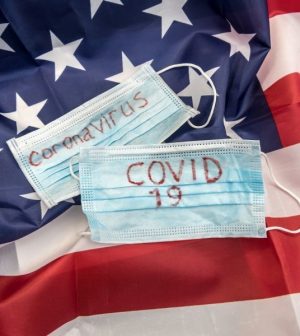- Skip Storing This Everyday Product in the Fridge Door
- Green Tea + B3 Pairing May Boost Brain Health
- Navigating Your Midlife Crisis: Embracing New Possibilities
- City Raccoons Showing Signs of Domestication
- Mapping the Exposome: Science Broadens Focus to Environmental Disease Triggers
- One Week Less on Social Media Linked to Better Mental Health
- Your Brain Changes in Stages as You Age, Study Finds
- Some Suicide Victims Show No Typical Warning Signs, Study Finds
- ByHeart Formula Faces Lawsuits After Babies Sickened With Botulism
- Switch to Vegan Diet Could Cut Your Greenhouse Gas Emissions in Half
Less Social Distancing in Areas With More Trump Supporters: Study

FRIDAY, April. 23, 2021Politics matter when it comes to Americans’ health: A new study shows that lower-income Republicans are less likely to socially distance than others.
The data — from more than 15 million cellphone users in more than 3,000 U.S. counties between March 2020 and January 2021 — also found that Black and Hispanic Americans were also less likely to maintain physical distance.
The findings were published online April 22 in the American Journal of Preventive Medicine.
“We started this project in April 2020 because we wanted to understand the social, economic and political factors that drive people to engage in social distancing,” said lead author Nolan Kavanagh, a medical student at the Perelman School of Medicine at the University of Pennsylvania.
“A year is a long time to prepare policy responses and educate the public,” Kavanagh said in a journal news release. “Yet, the same kinds of communities that struggled to physically distance early on continue to struggle now.”
To measure social distancing, researchers used averages of distance traveled per person between cellphone locations.
Social distancing was highest from late March to early June of last year, then returned to lower levels. Distancing began to increase again in early September.
Researchers found that the one consistent predictor of distancing was higher income, and the one consistent predictor of lack of distancing was voting for former President Donald Trump.
Early in the study, counties with more Black residents and Hispanic residents were less likely to socially distance. These differences closed during the summer before reemerging in the fall.
Researchers said several factors underlie these findings.
Those with lower-income or gig jobs, for example, may not be able to work from home. Those with lower incomes may be unable to buy in bulk and therefore, must shop more often for groceries and other items.
These findings also show that political differences that shape social distancing extend beyond the 2020 election.
Both low-income and Republican-leaning people are at greater risk for COVID-19, researchers noted.
“These results suggest that policy responses to the pandemic have failed to level the playing field,” Kavanagh said. “We have not addressed the challenges to physical distancing faced by low-income Americans, such as working from home. And messages by political and public health leaders have not reached populations who may have different beliefs about disease risk.”
He said analyses like this one that monitor disparities over time can help officials target public health and economic interventions to the communities that need them most.
More information
For more on COVID-19, see the U.S. Centers for Disease Control and Prevention.
SOURCE: American Journal of Preventive Medicine, news release, April 22, 2021
Source: HealthDay
Copyright © 2025 HealthDay. All rights reserved.










